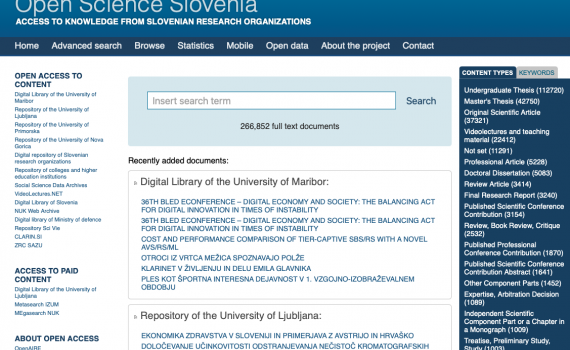
BACKGROUND
Until 2011 information on open access (OA) in Slovenia was scattered. Individual OA enthusiasts and supporters were promoting OA and sharing information with academic and research communities, but their efforts were not coordinated.
In February 2011, representatives of Slovenian universities, research institutions and libraries met to discuss how to promote OA in Slovenia in a more organized way. The meeting decided by consensus that a web-portal would be the most effective tool for deepening understanding about the benefits of OA, and how OA could improve visibility of Slovenian research.
This work became more urgent in April 2011 when the Slovenian Government approved the Research Infrastructure Development Plan 2011-2020. The plan set out Slovenia's priorities for development of international and national research support infrastructure and participation in large-scale European projects. Among the listed priorities is incorporation of OA in national infrastructure for depositing data and publications from publicly-funded research.
With a small grant from EIFL, a consortium of 13 Slovenian universities, research institutions and research libraries launched an OA awareness-raising and advocacy campaign. The main engine for the campaign was to be a national web-portal to share knowledge about OA, in Slovenian.
Since then, EIFL has collaborated with Slovenian organizations on open science policy development and skills building. EIFL also supported open access, open research data and open science in Slovenia through the FOSTER (Facilitating Open Science Training for European Research) project (2014-2019) and OpenAIRE (Open Access Infrastructure for Research in Europe) project (2009-2021) and the PASTEUR4OA project (2014-2016).
MAIN ACTIVITIES
- Developing a consortium of universities and research institutes to take forward OA and open science awareness-raising and advocacy.
- Creating, managing, evaluating and upgrading a national web-portal focused on OA and open science issues and developments.
- Organizing teams to provide a steady stream of up-to-date content and to promote use of the web-portal.
- Open science policy development and skills building.
TIMELINE
2011 - ongoing
ACHIEVEMENTS
The project has -
- Created a sustainable mechanism for organized and systematic dissemination of information about OA in Slovenian.
- The web-portal - openscience.si - included information for academics, researchers, librarians and OA journal publishers and editors about open science, open access and open data, including definitions of terms and a list of centres of support for OA in Slovenia. In 2013 the web-portal was transformed into the Open Science Slovenia portal, which enables deposit of and access to publications, research data and other types of research results from Slovenia.
- The web portal, openscience.si won recognition and support from the main national actors in research and development in Slovenia.
- The Ministry of Higher Education, Science and Technology, the Science and Technology Directorate at the Ministry, and the Slovenian Research Agency, among others recognize and support the web portal.
- National open access strategy was adopted.
- In 2015, the Government of the Republic of Slovenia adopted the national open access strategy 2015-2020, which was fully aligned with Horizon 2020 European Commission Research Framework Programme provisions on open access.
- Open science has been included in national laws and regulations.
- Open science provisions have been included in the Resolution on the Slovenian Scientific Research and Innovation Strategy 2030, the Scientific Research and Innovation Activities Act and the Decree on performing research activities according to the principles of open science. Open science provisions in Slovenia are fully aligned with Horizon Europe (the current European Commission Research Framework Programme) provisions on open science.
- In January 2023, the ‘Rules on conditions for providing library public service’ were revised and now require higher education libraries to ensure open access to final works of studies and publications of employees of higher education institutions. A library has to comply with the provisions of this act to be publicly funded.
- A national open science community was set up.
- The Slovenian Community of Open Science odprtaznanost.si was established in 2022 to promote and support development of open science.
- Public research organizations are being transformed according to the principles of open science
- In January 2023, the Ministry of Higher Education, Science and Innovation supported a project for transformation of public research organizations according to the principles of open science. 21 universities, institutes and the Central Technical Library established a consortium covering more than 90% of public research organizations in Slovenia. The consortium project, titled Support for implementation of open science principles in Slovenia, was chosen for funding from the national Recovery and Resilience Plan in the amount of 4 million EUR (for the period 2023-2026).
- At the University of Ljubljana, open science is included in the Statutes and in the Strategy 2022-2027. PhD students need to prepare a research data management plan for FAIR (Findable, Accessible, Interoperable and Reusable) data, as open as possible, as closed as necessary.
- Universities, research institutes and a national funder have joined the Coalition for Advancing Research Assessment (CoARA), that sets a shared direction for changes in assessment practices for research, researchers and research performing organizations, with the overarching goal of maximizing the quality and impact of research.
- All Slovenian journals that receive national public co-funding are open access
- Universities, research institutes and learned societies publish more than 140 peer reviewed OA journals.





